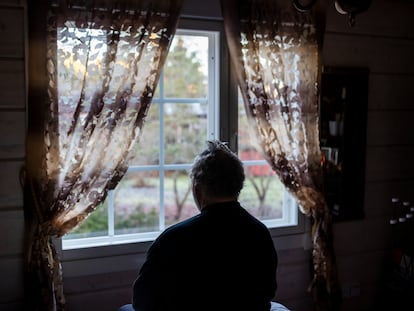Aerobic exercise, an ally against premenstrual syndrome
Activities such as swimming, walking or running may be effective in reducing PMS
“I’m in pain and I can’t move. I have diarrhea and my stomach hurts. I’m swollen like a balloon and I haven’t gotten my period yet.” One of my patients sent me that message to make me aware of her physical condition before a training session. “Did you go to the gynecologist?” I asked. “Yes, I tell him about all this at every checkup, but he tells me that it’s normal,” she replied.
Unfortunately, normalizing pain is common. We need a more comprehensive perspective when it comes to women’s health. More education and research is needed. If men suffered from some of the symptoms related to the onset or lack of menstruation, their treatment would likely have advanced further and received the attention they deserve.
Every age brings its own unique needs. Though it may seem like an illusion at first sight, there is a non-pharmacological procedure that can help at all stages: physical exercise. During the fertile period, clinically significant symptoms of premenstrual syndrome (PMS) may appear during the luteal phase of the cycle.
The exact mechanism that causes PMS is still not clear. However, it is recognized that it could be associated with increased sensitivity and an excessive response to hormonal changes. It occurs one week before the start of menstruation in reproductive age and decreases with the start of the period. Several researchers have found that various body systems —including cardiovascular, central nervous, endocrine, and reproductive— may be associated with PMS.
PMS affects 47.8% of women of reproductive age worldwide. About 20% experience symptoms severe enough to interrupt their daily activities, and the rest have mild to moderate signs. Manifestations include changes in appetite, weight gain, abdominal pain, back pain, lower back discomfort, headache, breast swelling and tenderness, nausea, constipation, anxiety, irritability, anger, fatigue, restlessness and mood changes. .
“I have pleaded to be heard and, when I decide to talk about it, I have the feeling that nobody is on my side. I won’t be able to work out today. It hurts me. It will go away with the pill, but I have to stay on the sofa until it goes away ,” my client explained to me. We are all different, and we all experience our bodies differently. But the discomfort of PMS should not be dismissed. According to the American College of Obstetricians and Gynecologists (ACOG) , non-pharmaceutical therapy is recommended as the primary treatment for the condition. This is where physical exercise comes in: since it is considered a beneficial alternative to medications for managing premenstrual symptoms, and it has been associated with improved well-being.
Pain, discomfort and movement
“I don’t move because it hurts, and it hurts more because I don’t move.” It seems paradoxical, but it reflects a reality. Physical activity could potentially improve our hormonal profile, reproductive function, menstrual cycle regularity, ovulation and fertility at all our ages.
Have you thought that going for a walk could reduce the discomfort of PMS? According to the findings of the review published in the International Journal of Women’s Health, 30 minutes of moderate-intensity aerobic exercise (such as swimming, walking, or running) performed 3 to 5 times a week , for 10 weeks, could be effective in reducing the physical and psychological symptoms of PMS.
We all experience fluctuations in the levels of estrogen, progesterone and serotonin. Studies suggest PMS comes from an imbalance between ovarian hormones (estrogen and progesterone). Estrogen levels increase during the premenstrual phase, with insufficient levels of progesterone to counteract it. Can anything be done to reduce estrogen? Probably doing aerobic exercise. Aerobic means “with oxygen,” which implies that breathing controls the amount of oxygen that can get to the muscles to help them “use up fuel” and move us.
Beta-endorphin, behind the cravings and cramps
Have you ever felt the need to eat sweets or fatty foods? Have you craved food outside of your usual diet during the premenstrual period? Beta-endorphins may have something to do with those behaviors. These are substances that are produced in the brain, especially in the pituitary gland, and block the sensation of pain. They are generated in response to discomfort, exercise, and other forms of stress. These peptides exert a wide variety of effects throughout the body. As an opioid receptor agonist, they are best known for their potent analgesic effects, but they also play a role in reward-focused behaviors and in restoring homeostasis.
The journal PLOS One showed that plasma beta-endorphin levels decrease during the premenstrual phase and contribute to symptoms such as headache, menstrual cramps, anxiety and food cravings. Several studies, such as one published by the International Journal of Molecular Sciences, suggest that moderate-intensity aerobic exercise has shown an increase in circulating beta-endorphins.
Cortisol, often referred to as the “stress hormone,” regulates a wide range of vital processes throughout the body, including metabolism, the immune response, and plays an important role in completing the healthy stress response circuit in the body. As studies such as one published by Stress demonstrate, performing aerobic exercise at an intensity of at least 60% of the maximum oxygen absorption capacity leads to elevated cortisol levels for at least two hours afterwards. Cortisol can inhibit the hypothalamus and pituitary glands and restore homeostasis for a healthy stress response.
Try it yourself
The symptoms of premenstrual syndrome in women of reproductive age are associated with discomfort and functional impairments. Is there a non-pharmaceutical treatment to combat the discomfort it brings? Aerobic exercise would seem to be a good option.
Have you considered joining the “walking club” and adding aerobic activity to your daily routine? The WHO recommends that adults aged 18 to 64 spend at least 150 minutes a week in moderate-intensity aerobic physical activity, or 75 minutes of vigorous aerobic physical activity each week. Put that way, it may seem like a lot for a sedentary person, but every step counts. Health is measured in habits. We can add aerobic exercise to our routines and enjoy it. The secret: make it yours. Enjoy it.
- Walking can be a cheap, accessible alternative and a good start.
- Begin to do your daily activities on foot, little by little, progressively. One week you can walk to work; another week, to take your kids to school; the next to visit a relative.
- Give yourself small challenges and associate them with a good experience, such as seeing a beautiful landscape or listening to music, when you go for a walk. Think of it as your moment. Sustainability comes hand in hand with pleasure and implies doing things out of enjoyment, not out of obligation.
- You can also walk with the company of loved ones.
Exercise has been proven to extend life. Taking into account that it increases well-being and reduces the discomfort derived from PMS, we can see that by being active, we can live longer and better. Welcome to the walking club.
Sign up for our weekly newsletter to get more English-language news coverage from EL PAÍS USA Edition
Tu suscripción se está usando en otro dispositivo
¿Quieres añadir otro usuario a tu suscripción?
Si continúas leyendo en este dispositivo, no se podrá leer en el otro.
FlechaTu suscripción se está usando en otro dispositivo y solo puedes acceder a EL PAÍS desde un dispositivo a la vez.
Si quieres compartir tu cuenta, cambia tu suscripción a la modalidad Premium, así podrás añadir otro usuario. Cada uno accederá con su propia cuenta de email, lo que os permitirá personalizar vuestra experiencia en EL PAÍS.
¿Tienes una suscripción de empresa? Accede aquí para contratar más cuentas.
En el caso de no saber quién está usando tu cuenta, te recomendamos cambiar tu contraseña aquí.
Si decides continuar compartiendo tu cuenta, este mensaje se mostrará en tu dispositivo y en el de la otra persona que está usando tu cuenta de forma indefinida, afectando a tu experiencia de lectura. Puedes consultar aquí los términos y condiciones de la suscripción digital.
More information
Últimas noticias
Most viewed
- Sinaloa Cartel war is taking its toll on Los Chapitos
- Oona Chaplin: ‘I told James Cameron that I was living in a treehouse and starting a permaculture project with a friend’
- Reinhard Genzel, Nobel laureate in physics: ‘One-minute videos will never give you the truth’
- Why the price of coffee has skyrocketed: from Brazilian plantations to specialty coffee houses
- Silver prices are going crazy: This is what’s fueling the rally











































